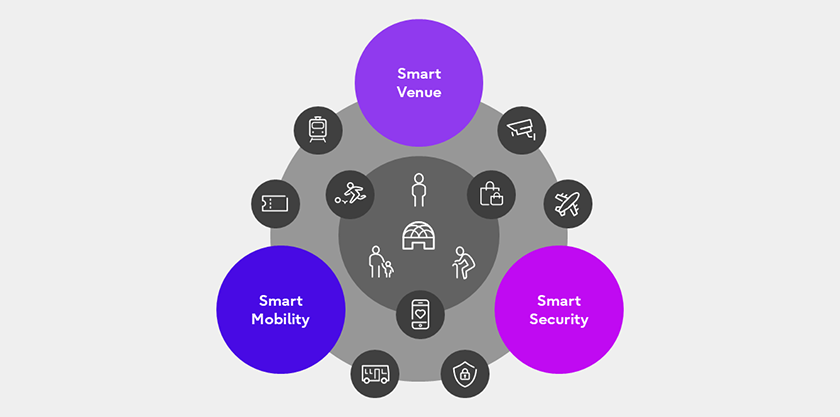Contribution to resolve environmental challenges for customers and society through our business operations
Fujitsu’s business aims to transform its portfolio and offerings by 2030, focusing on ESG contributions and Sustainability Transformation (SX, *1). In line with its materiality focus on solving global environmental issues, Fujitsu provides a range of cross-industry offerings, from supply chain optimization through to energy efficiency. Notably, we are promoting the development of solutions and initiatives that contribute to SX, targeting both customers and society as part of our Stage XI Environmental Action Plan for 2023 to 2025. Below are examples of Fujitsu’s initiatives for helping to resolve environmental challenges for customers and society through its business.
*1: Sustainability Transformation
Data-driven response to uncertainty
In times of uncertainty, companies face various challenges at the management, operational, industry and society level. To address these challenges, and maintain and enhance competitiveness, speedy high-level decision making based on data is essential.
Fujitsu offers customers a data-driven management approach to achieving organizational goals. This approach uses data to derive the hypothesis with the highest impact. Through a cycle of increasing real data, linking data correctly, assigning values to data and creating new experiences, we are supporting the transformation of management, business operations, industries and society by advancing Digital Transformation (DX) solutions.
DX solutions with three transformations provided by a data-driven approach
-
Management transformation
- Increased sophistication of decision-making: More advanced decision-making through data, moving from numbers-based management to strategy formulation and decision-making.
-
Business operations transformation
- Traceability: More efficient business processes by linking data to ensure transparency of manufacturing processes and transactions.
- Demand forecasting: Greater efficiency through data-driven planning and business processes.
- Advanced facilities operation: Risk-based maintenance through data-driven fault detection.
- Quality management: Support of enhanced quality through data integration from design and production through to after-sales support.
-
Industry and society transformation
- Transformation of entire industries: Creation of new systems and value across entire industries.
- Achievement of carbon neutrality and migration to a circular economy: Aiming to contribute to a sustainable society through use of data to reduce environmental impact.
Fujitsu provides Fujitsu Data Intelligence PaaS (DI PaaS) to realize this data-driven decision making and progress powerful solutions to DX topics. DI PaaS is a cloud-based all-in-one operation platform that integrates vast amounts of data from both inside and outside organizations into a meaningful format to support decision-making. It consists of the world’s most advanced AI solution “Fujitsu Kozuchi”; the “Sustainability Value Accelerator” that enables traceability; and “Data Life-Cycle Utilization” that includes Palantir Foundry and Microsoft Azure/Amazon Web Services for achieving complex data integration, application development, and advanced AI. Using these technologies, DI PaaS helps customers solve their challenges by enabling the integrated connection and analysis of data that has been fragmented across industries, leading to unprecedented cross-value chain solutions and insights. Furthermore, by seamlessly linking these decision-making outcomes with Fujitsu's long-standing planning and execution systems, DI PaaS empowers autonomous operation of business processes from decision-making to action, enhancing agility and responsiveness to change.
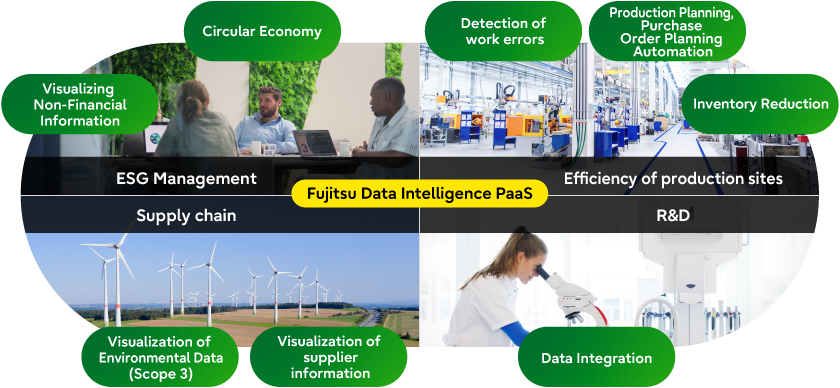
Creation of new value by achieving value-chain traceability across companies and industries
The Sustainability Value Accelerator enhances the transparency of the value chain by collecting verifiable traceability data, enabling collaboration across companies and countries. Through trusted data sharing and cross-company impact simulations, it supports the optimization of the entire value chain and the creation of new business models, helping companies fulfill their social responsibilities while improving profitability. This value chain restructuring supports customers in achieving their business goals and contributes to market revitalization.
Our approach to solutions
- Drive business growth through sustainable procurement: We enable traceability that provides proof of origin both for primary production products, and for secondary products created through recycling and reuse. This clarifies the process by which products are being reused, ensuring transparency for consumers and businesses. We enhance product reliability and promote responsible resource use throughout the supply chain through data collection and management from raw material procurement for primary products to the recycling process for secondary products. This contributes to enhancing brand value by providing sustainable products and appealing to environmental considerations.
- Enable data collaboration between companies in different industries: Reduction of greenhouse gas (GHG) emissions is a prime example of a scenario where data collaboration is essential. GHG emissions reduction is challenging for individual companies to achieve alone, and requires a concerted effort across the entire supply chain. Collecting data from upstream and downstream partners is particularly important for reducing Scope 3 emissions. However, traditional monetary-based calculations often fail to reflect the efforts of suppliers. Therefore, calculating Product Carbon Footprints (PCF) based on primary data, which requires data collaboration, is crucial. Sustainability Value Accelerator contributes to visualizing and reducing emissions through data collaboration across the entire supply chain, adhering to international standards such as WBCSD PACT.
- Realize a decarbonized society through data-driven carbon credits: We digitize and automate the work required by knowledge specialists to measure, report, and verify CO₂ emissions. The workload for both companies generating both J-Credits (*2) and those responsible for certification is significantly reduced, enabling a faster path to monetization. Fujitsu supports the creation of highly trusted J-Credits by undertaking registration as an MRV support system operator in the J-Credit system.
- *2: Under the J-Credit Scheme, the Japanese government certifies the amount of greenhouse gas emissions (such as CO₂) reduced or removed by sinks through efforts to introduce energy-saving devices or use renewable energy and manage forests, as "credit.“ J-Credits are categorized into compliance credits based on systems managed by countries and governments, and can be used for regulation compliance.
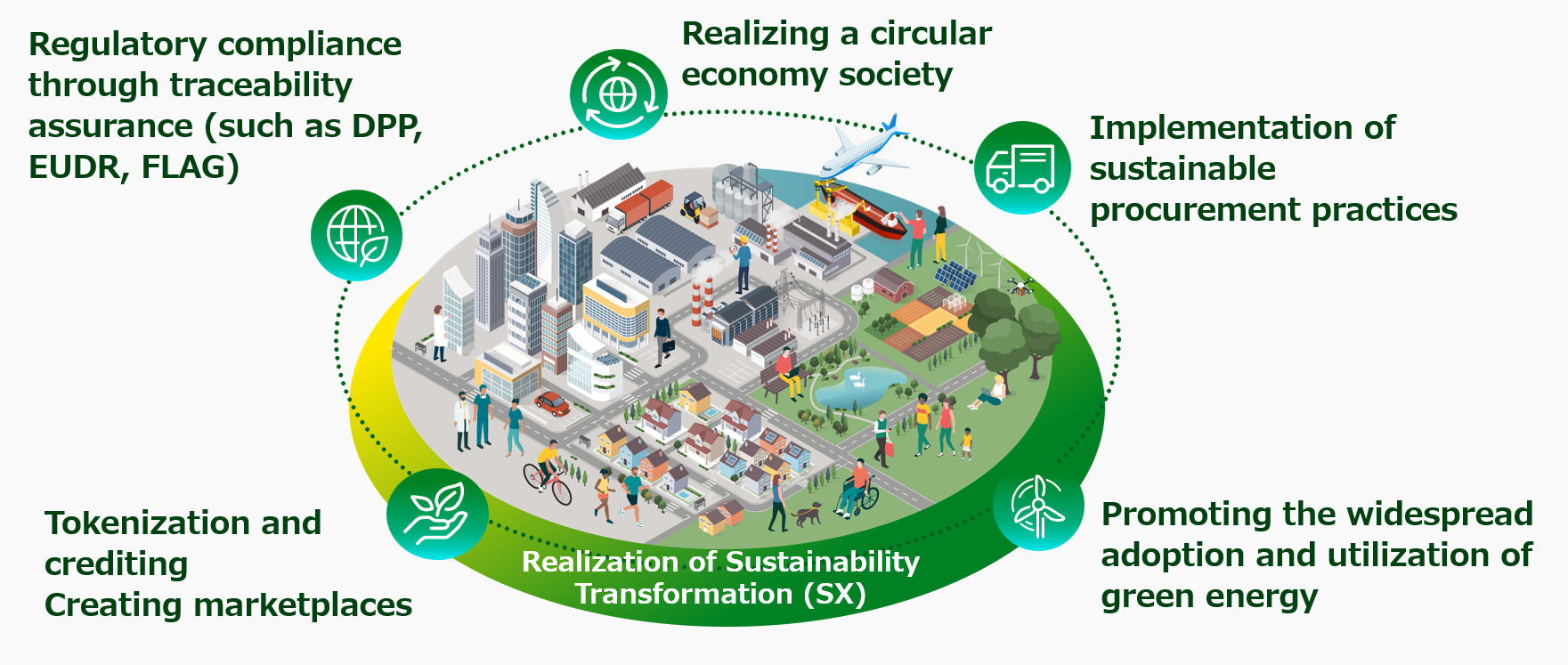
Achieving sustainable consumption by stimulating demand through personalized marketing
With increasing diversification of consumer behavior, companies face challenges in accurately understanding demand as well as reducing waste such as food loss while increasing profit.
By understanding consumer needs using AI-based personalized marketing services, Fujitsu supports demand stimulation to price optimization. Supply and demand balance can be maximized throughout the entire supply chain, reducing waste while providing business sustainability.
Our approach
- Demand creation and customer experience optimization: Enhances the consumer purchasing experience through optimized AI recommendations based on purchase data.
- More efficient promotional activity: Effectively drives demand using generative AI to automatically create optimized promotional contents based on consumer behavior data.
- Waste reduction through dynamic pricing: Reduces unsold goods and waste through automatic generation of optimal pricing based on AI analysis of demand.
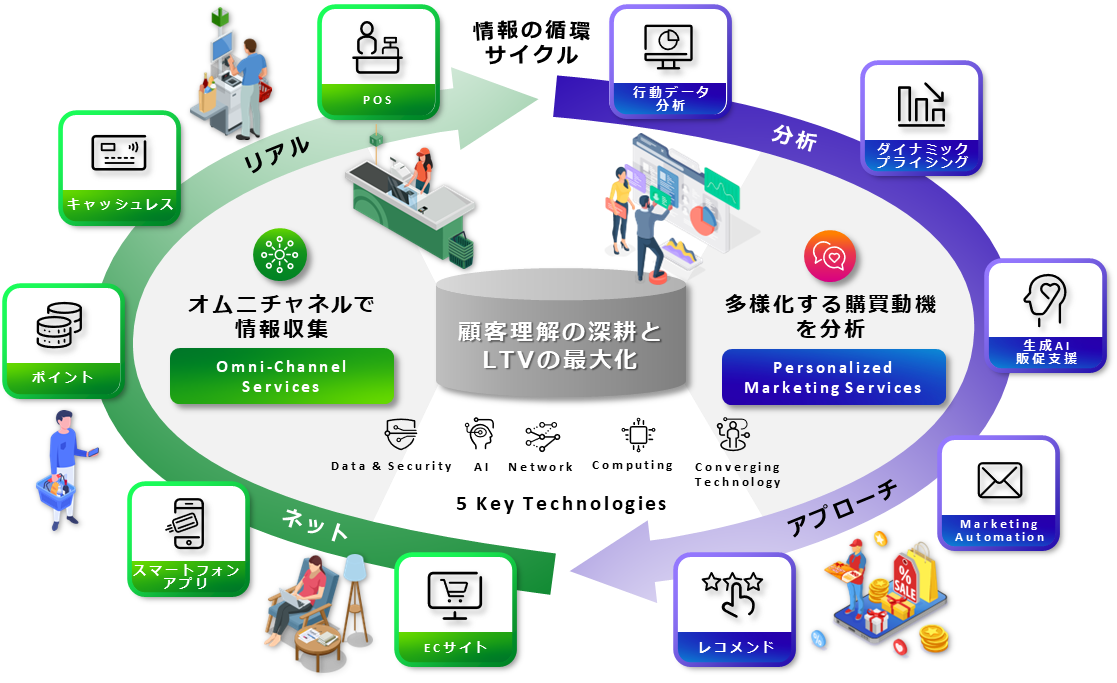
Supports transformation to business sustainability through data linkage throughout the supply chain
Organizations are facing complex pressures in their supply chains, with frequent external changes and uncertainties in consumer trends, geo-political risk, tariff fluctuations, procurement chaos and environmental impact reduction. They must forecast changes, formulate responses based on multiple factors, and quickly reflect those measures in their business operations.
Through Dynamic Supply Chain Management (DSCM), Fujitsu enables visualization and simulation of the entire supply chain, permitting speedy yet flexible responses with end-to-end linking even of complex operational instructions. This supports transformation to a truly sustainable data-driven business and maximizes profits while minimizing environmental impact to achieve a resilient supply chain.
Our approach to solutions
- Supply chain visualization and plan optimization: While utilizing existing business processes and systems, enhances visualization of the entire supply chain by consolidating dispersed data, and optimizes planning with technologies such as AI.
- Risk forecasting and strengthened resilience: Uses risk and loss simulations through digital rehearsals to build systems that can respond to unforeseen circumstances such as natural disasters.
- Links to cross-organizational operational instructions:Enhances cross-organization business agility by quickly reflecting plan changes due to sudden modifications or unexpected problems, to supplier order processing or logistics operations.
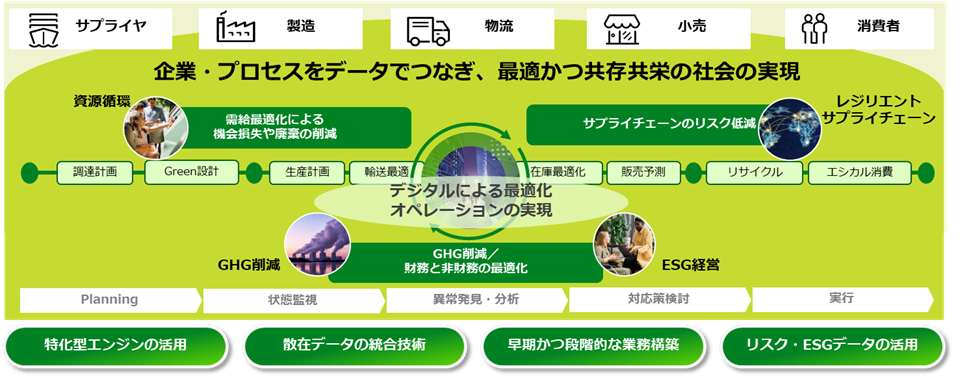
Efficient development processes with visualization and automation connected by digital threads
Manufacturing industry processes, from product design through to production preparation, must consider the environment, as well as provide shorter lead times, lower costs, and higher quality.
Fujitsu links the entire product lifecycle using digital threads with PLM at the core, to realize sustainable manufacturing premised on ESG environmental consideration. GHG emissions can be visualized and optimized in real time by linking environmental information to the Bill of Materials (BOM) from an early design stage. We support sustainable growth of manufacturing industry via efficient development processes that achieve both regulatory compliance and competitive product development.
Our approach to solutions
- Integration and visualization of environmental information using digital threads: We build an environmental BOM that links the Engineering BOM to environmental information with PLM-centered digital threads. GHG emissions can be visualized in real time over the entire product lifecycle with integrated linking of data procurement from the supplier through to design and manufacture, promoting environmental consideration from the early design stages.
- Automation of the development process through simulation and optimization: Linking LCA, MBD (Model-Based Design) and 3DCAE (Computer-Aided Engineering), we use a digital twin with automated multi-purpose optimization and simulation of environmental impact and product performance. This enables efficient design in a shorter development time by automating selection of the best material, shape or manufacturing method to achieve environmental goals.
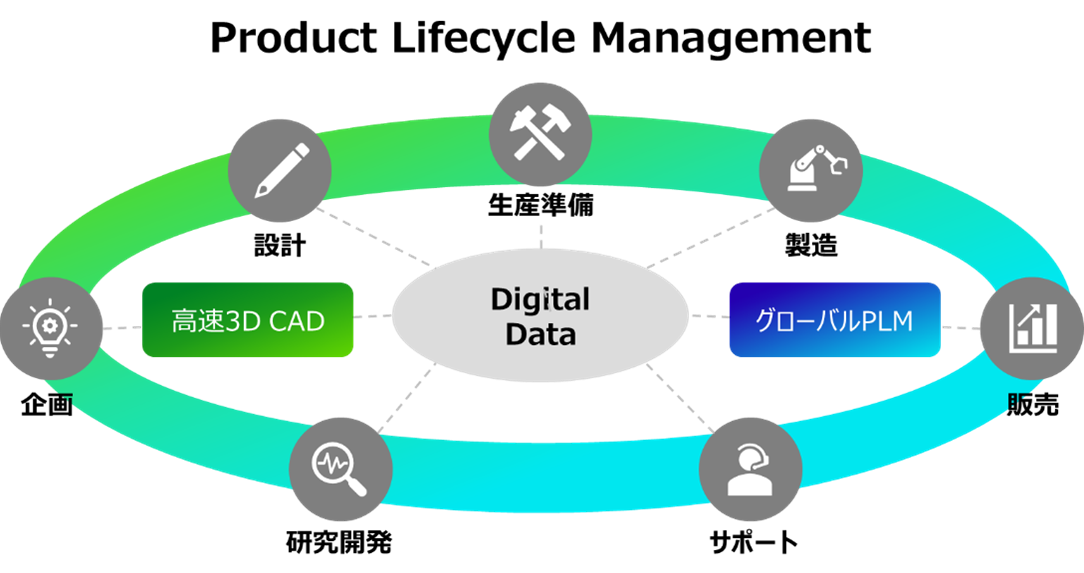
Utilizing AI and ICT to improve comfort, convenience, and safety, and enhance the appeal of Urban spaces
As population aging accelerates and labor shortages become more severe, there is a growing need to flexibly respond to consumer needs and create more livable cities. Providing a safe and secure environment and fostering vibrant urban spaces where diverse people can gather, is essential to promoting sustainable and enriched urban development.
Fujitsu Group's 'Smart Space' optimally connects all elements—people, facilities, and services—to create comfortable and attractive area experiences that people are drawn to. By harnessing the power of data and AI, we aim to transform facilities and cities into safer, more secure, and more appealing spaces.
Our approach to solutions
-
Unifying Facility Operations and Surrounding Services on a Single Platform:
By centralizing the management of facilities and ticket sales, we enhance the user interface (UI) and user experience (UX). This integration promotes mutual customer referrals between complex facilities and enables autonomous facility management without relying on human intent or decision-making.
-
Automatic Detection and Tracking of Suspicious Behavior with Efficient On-Site Response:
By using video analysis AI for behavior detection and tracking, suspicious activities can be automatically identified. This enables optimal assignment of response personnel and supports timely on-site action. As a result, facility safety is enhanced, allowing users to feel secure and use the space with peace of mind.
-
Stress-Free Mobility Through Diverse Transportation Options and Optimal Deployment:
By utilizing a comprehensive traffic simulator to derive optimal multimodal mobility strategies and deployments (MaaS), we reduce the stress associated with user transportation. This enables smoother and more comfortable travel to destinations, contributing to the revitalization of the entire city.
